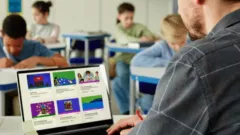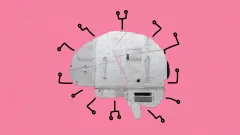Showing 120 results
April 4, 2019
Fun way to create and explore the ideas behind computer programming for a very young audience.
My overall opinion of this program as a teaching tool is positive. I love that the children have the opportunity to create their own program, watch what happens, make changes and play around with it. We only tried out Scratch Jr. and that would be a perfect tool for introducing young children to computer programming.
Continue reading
February 5, 2019
I love Scratch because it gives students the possibility to create new things, but also check other people's work to be inspired. The new "tutorial" feature is amazing!
I believe that Scratch helps students see that there is more than one solution to each problem and that each person sees things differently.
Continue reading
December 29, 2018
Amazing way to teach coding for 3rd graders on up
It is a great way to teach. There are so many ways to use it, but it does take a while for students to do. It makes a great Friday project or after school class. If you let the kids really play with it they will learn faster than if you try to teach each aspect of coding. This is great for younger kids but after junior high students should move on to more difficult programs.
Continue reading
November 28, 2018
Perfect way to introduce children to coding and computational thinking
There is a learning curve with this tool, but it is definitely worth the time investment. I recommend students (and teachers!) use the scratch cards and scratch starter projects to get started. It helps to learn some basic blocks before trying to use them to create a school project. In other words, it's helpful to designate time to become familiar with the tool before applying it to curricular content.
Continue reading
December 2, 2017
Great way to learn coding for elementary and middle school students
Scratch is a great tool to introduce coding concepts into a classroom while teaching the students about other things. Nowadays many of my students come to me already conversant in Scratch, while others are new to the tool. I use the opportunity to teach elements of literacy to all of my students, while bringing those new to Scratch (or coding in general) up to speed.
Continue reading
October 3, 2017
I found this to be a very fun and imaginative way to learn basic coding. It is simple with cute characters for the lower level learners, but it can be built upon and get more complex for the higher level learners. This is an exciting app for all learners!
I liked this product as a teaching tool. It is captivating, creative, and educational.
Continue reading
October 2, 2017
Works from Kindergarten through GRAD School!
I have seen this used in Kindergarten classes. I have helped a friend in PT school complete an assignment with it. The sky is the limit with Scratch. You can make nearly whatever you want with it. It is creative and inspires the use of intelligence.
Continue reading
September 8, 2017
Great intro to the ideas, structures, and vocabulary of computer programming with room for learners to express themselves creatively.
Age Group: 8-16 years old,
Actual User Demographics: 37% of users age 12 and under; 36% of users age 13-17; 27% of users age 18+
Content Area: digital literacy, computer programming
Specific Skills:- creative thinking, systematic reasoning, collaboration, mathematical reasoning, computational reasoning
Computer Science concepts: conditionals, loops, timers, booleans, events, logical operators)
Product Claims
Stated Goal: “Scratch helps young people learn to think creatively, reason systematically, and work collaboratively.”
A research paper published by MIT Media Lab in Nov. 2009 (just over two years after Scratch’s May 2007 public release) states that the site was founded on the belief that “‘digital fluency’ should mean designing, creating, and remixing, not just browsing, chatting, and interacting” (DOI: 10.1145/1592761.1592779). It was designed to be “more tinkerable, more meaningful, and more social” than earlier and existing programming environments, which are viewed by many, the paper attests, as only accessible to a few very intelligent or technically skilled people.
One of the nice things as a new user is that the site is full of step-by-step tutorials and examples. While some may enjoy the freedom to experiment and click through the different menus trying things, others may appreciate some direction. The possibilities range from simple race games (click a button to move characters horizontally across the screen) to complex Tetris analogues and extended videos with extensive animated storylines. As the team states, “our primary goal is not to prepare people for careers as professional programmers but to nurture a new generation of creative, systematic thinkers comfortable using programming to express their ideas” (DOI: 10.1145/1592761.1592779). Thus, users do not learn a formal programming language like C++, JavaScript, or Python, but they do learn the concepts and structures that underlie these languages. There is certainly room for users to grow with the system.
Evidence Regarding Product Claims
While working with the system, I did find Scratch to be a “tinkerable” programming environment. Statements are separated into blocks that serve different purposes. Blocks can move an image in the view screen, create a conditional if-this-then-that controls, loop to repeat actions, play sounds, take user input, and many other things. The blocks are color-coded based on what they do, and have notches on the top and/or bottom showing the possibility to link other statements before and after. Control structures like loops and if-statements look like extended brackets, visually indicating to the user that other things can be put inside. Because there is no messy syntax and punctuation to worry about, if the blocks fit your statement is executable. Furthermore, you can have multiple groups of commands in your workspace not necessarily attached- just click the one you want to execute. This encourages the user to try things without having to have a complete plan in place before they start.
In terms of meaningful, being able to create many different things like games, animations, story lines, quizzes, songs, and so many other things provides room for a student to express herself and personalize her experience. It clearly sends the message that computer programming is accessible and can be used to support many different areas of interest and levels of ability. It is certainly rich in computer programming content, offering ways for students to experiment with their creativity while gaining experience with real programming terms and ideas of if-then-else, true-false, and-or-not, and variables among other things.
In terms of social, the website provides the ability to view projects other users have chosen to share (projects are accessible only to the creator by default). The online community supports and values a concept of “remixing.” When viewing a shared project, the user can “See Inside” to view the code alongside the execution. Then, by hitting the “Remix” button you create a copy of the other user’s scripts in your own workspace. This allows users to tinker, changing settings, adding features, and figuring out how the code works. If you chose to share your remixed version, the site automatically provides a link to the original users version to give credit. There are also opportunities to collaborate with other users, forming teams to work on large projects and share skills and ideas. Learning from each other is key in the collaborative, social aspect of Scratch.
Research
The system is produced by the Lifelong Kindergarten Research Group at the MIT Media Lab. The project has been the subject of 45 research papers and presentations, and the program has received seven National Science Foundation grants. In addition to MIT, researchers from University of Pennsylvania, Harvard, University of Washington, University of California-Irvine, College of Charleston, Utah State University, Indiana University, and Microsoft Research have published papers and presented at conferences about the learning model, the system itself, and its outcomes. Material for this research comes from the site itself. As the privacy policy states, “Any publicly shared projects, comments, or other material on the Scratch site may be included in the research analysis, presentations, papers, and reports.”
Privacy
The website has a clear privacy policy spelled out in accessible language. It consists of four sections: What information does the Scratch Team collect about me, How does the Scratch Team use my information, How can I update my personal information, and How does the Scratch Team protect my information? The privacy policy states that Scratch will never sell or share email addresses. De-identified information (location, gender, age, and usage) are shared with researchers and educators for research purposes. The system does use cookies to remember user login information. Scratch also uses Google Analytics to improve their website. Google Analytics collects “IP addresses, network locations, and geographic locations,” as well as “which pages you visited, and what browser you are using,” according to the Scratch website. The site requires a parent or guardian’s email address with registration of any child under 13-years-old, and the parents must click a link in an email to activate the student’s response. Educators are encouraged to read the full privacy policy and consult with your district’s policies before deciding if these terms are acceptable for your students.
Continue reading
August 17, 2017
Students learn programming and coding with blocks to create digital animations, video games and more.
Scratch is incredibly popular among elementary and middle school students and allows them to show their creativity using a digital coding tool. It is completely free through the website, but is also available as a downloadable offline editor. I wish it were the same on an iPad, however. There is a Scratch Jr app for the iPad, but it’s very different; the iPad app is geared towards K-2, while the Scratch website is for older students.
With both formats, students learn the basics of coding (including loops, conditional statements and procedures) in an easy-to-use way while creating animations and games. I find my students enjoy saving the games on the website and playing with (and showing them off to) their friends anytime.
Across the curriculum, students can create animations to show their understanding of various topics. For example, students can use pictures of moons to show the different phases of the moon. They can use Scratch’s library of characters and objects or upload their own from an Internet search.
Continue reading
August 13, 2017
All Students Can Code!
Scratch helps students to learn how to code. This increases the students' problem solving and logic skills. The students also learn how to work cooperatively because if they cannot solve something, they can always ask a neighbor. Once the students know the basics of how to get the items to move and change and speak, they can create products that demonstrate their learning and understanding in other content areas.
Continue reading






